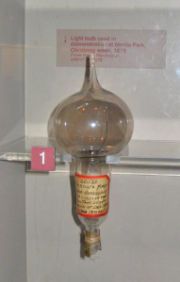 Edisons första glödlampa såg ut så här. Nu är en fullständigt återvinningsbar glödlampa på g. Bara glas, aluminium och fosfor. Inget kvicksilver. Nedan får Du mitt utdrag från GreenTech Media presentation och bild på en prototyp.
Edisons första glödlampa såg ut så här. Nu är en fullständigt återvinningsbar glödlampa på g. Bara glas, aluminium och fosfor. Inget kvicksilver. Nedan får Du mitt utdrag från GreenTech Media presentation och bild på en prototyp.
Eden Park Illumination, a University of Illinois spin-out, has created what it calls microplasma lights that will produce 40 lumens of light or more per watt. In these lights, two glass or plastic panels create a sandwich. Inside the sandwich sits an aluminum mesh dotted with microcavities filled with phosphors. When a current is passed through the sandwich, the phospors get excited and light is generated. You’re looking at a prototype in the picture.
But that’s all that’s in the light — aluminum, phosphors and glass. There’s no mercury. “Adding mercury would increase the lumen output but the intent is to make it fully recyclable,” said CEO Philip Warner.
Like plasma TVs, plasma lights can be both large and thin. Imagine a wall covered in panels that emanate light. (Effects with color and brightness, depending on what the customer wants, can also be tuned.) LEDs produce more lumens per watt than plasma lights, but you’d need several LEDs in an array to get this kind of wall-of-light effect.
Other companies are trying to make similar lights out of organic light emitting diodes (OLEDs) and capacitors, but Warner claims that plasmas will have superior performance and lifetimes. Plasma lights can go for 40,000 hours. Eden will show off its lights at large trade shows next year and come out with lights commercially in 2010.



Senaste Kommentarer.